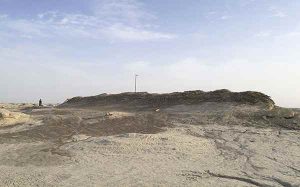Archaeologists unearthed ruins of ancient city, located on the eastern edge of the Silk Road, in the Lop Desert, Xinjiang Uygur Autonomous Region of China.

The remains of the city were found on the northern bank of Peacock River. Radiocarbon dating indicates that the relics could date back more than 1000 years. The ruins of the ancient city lie 57.5 kilometres Southeast of the ancient site of Loulan, discovered by Swedish explorer Sven Hedin in 1900. According to archaeologists, the layout of wall fragments indicates that the city might have been arranged in a circle, with a diameter of 300 meters. Loulan, also known as Kroraina, was one of the pivotal stops along the famous Silk Road, but disappeared around the third century AD.

Archaeologists have also found pottery fragments, copper arrows, copper bracelets, brass buckles and other remains, most of which originated during the Han (202-220 BC) and Jin (266-420 AD) Dynasties. Several nearby tombs were discovered as well. In two of the unearthed tomb pits, archaeologists found tapestry fragments, implying that the tombs in question were of a high standard. They believe the tombs were used to bury nobles from that period.

(after People’s Daily Online)